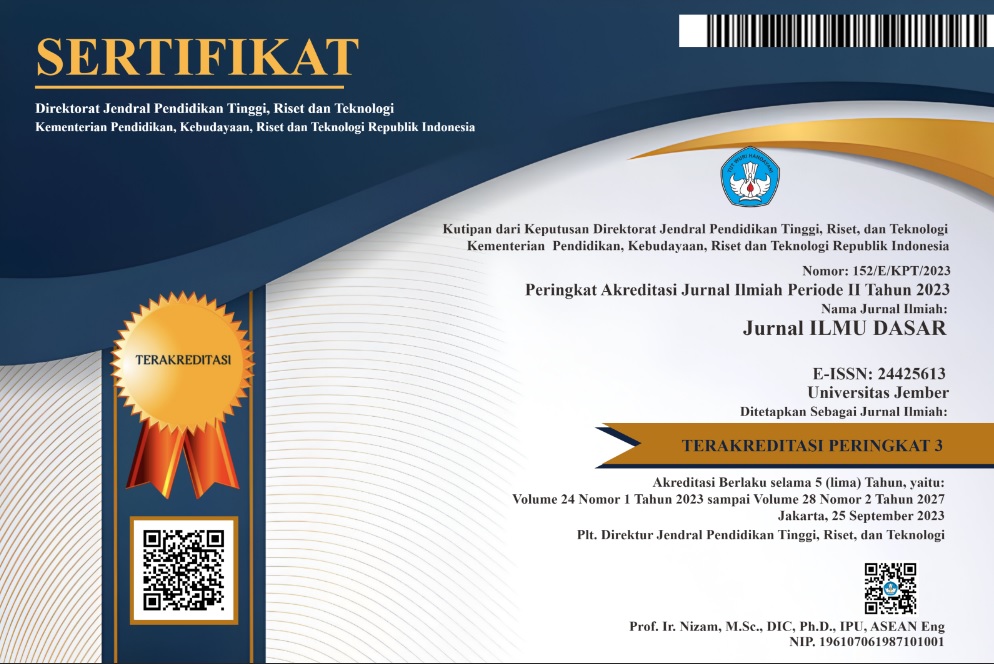The Effect of Pattern and Infill Percentage in 3D Printer for Phantom Radiation Applications
DOI:
https://doi.org/10.19184/jid.v23i2.27256Keywords:
3D printing, Hounsfield Unit (HU), PETG, Infill Density, Infill PatternAbstract
3D printing technology was capable of fabricating phantoms to enhance quality assurance in radiation therapy. The ideal phantom has properties equivalent to the real tissue. However, 3D Printing has the limits to mimicking the attenuation properties of various tissues because during 3D printing there can be only one type of material. The purpose of this study was to evaluate the effect of infill percentage and infill patterns of 3D printing technology to simulate various types of tissue. This study used 25 samples measuring 5 × 5 × 1 cm3 from PETG material. The 20 samples were printed using variations infill percentages from 5 - 100% and the infill pattern in lines. The five samples were then printed with the infill percentage constant at 50% and used the infill pattern triangles, grid, gyroid, octet, and concentric. We used Computed Tomography (CT) to determine the Hounsfield Unit (HU) value for each sample and evaluated the suitability of each sample for phantom applications in radiation therapy and radiology. However, none of the samples was able to simulate compact bone. As a result, we found that PETG material could simulate the properties of soft tissue, fat, lung, kidney, liver, pancreas, and spongy bone. Thus, the study had shown promising potential for the fabrication of the anthropomorphic phantom of radiation therapy.
Downloads
References
Craft DF & Howell RM. 2017. Preparation and Fabrication of A Full-Scale, Sagittal-Sliced, 3D-Printed, Patient-Specific Radiotherapy Phantom. Journal of Applied Clinical Medical Physics. 18: 285-292.
Hazelaar C, van Eijnatten M, Dahele M, Wolff J, Forouzanfar T, Slotman B & Verbakel WFAR. 2018. Using 3D Printing Techniques to Create An Anthropomorphic Thorax Phantom For Medical Imaging Purposes. Medical Physics. 45: 92-100.
Kadoya N, Abe K, Nemoto H, Sato K, Ieko Y, Ito K, Dobashi S, Takeda K & Jingu K. 2019. Evaluation of a 3D-Printed Heterogeneous Anthropomorphic Head and Neck Phantom For Patient-Specific Quality Assurance in Intensity-Modulated Radiation Therapy. Radiological Physics and Technology. 12: 351-356.
Kairn T, Crowe SB & Markwell T. 2015. Use of 3D Printed Materials as Tissue-Equivalent Phantoms, in: Jaffray, D.A. (Ed.), World Congress on Medical Physics and Biomedical Engineering, June 7-12, 2015, Toronto, Canada, IFMBE Proceedings. Springer International Publishing, Cham, pp. 728-731.
Kalender WA. 2011. Computed Tomography: Fundamentals, System Technology, Image Quality, Applications. John Wiley & Sons.
Khan FM, Gibbons (Jr.) JP. 2014. Khan’s The Physics of Radiation Therapy. Lippincott Williams & Wilkins.
Madamesila J, McGeachy P, Villarreal Barajas, JE & Khan R. 2016. Characterizing 3D printing in The Fabrication of Variable Density Phantoms For Quality Assurance of Radiotherapy. Physica Medica AIFB. 32: 242-247.
Martini N, Koukou V, Michail C & Fountos G. 2020. Dual Energy X-ray Methods for the Characterization, Quantification and Imaging of Calcification Minerals and Masses in Breast. Crystals. 10: 198.
Mayer R, Liacouras P, Thomas A, Kang M, Lin, L & Simone CB. 2015. 3D Printer Generated Thorax Phantom with Mobile Tumor for Radiation Dosimetry. Review of Scientific Instruments. 86: 074301.
Oh SA, Kim MJ, Kang JS, Hwang HS, Kim YJ, Kim SH, Park JW, Yea JW & Kim SK. 2017. Feasibility of Fabricating Variable Density Phantoms Using 3D Printing for Quality Assurance (QA) in Radiotherapy. Progress in Medical Physics. 28: 106.
Okkalidis N. 2018. A novel 3D Printing Method for Accurate Anatomy Replication in Patient-Specific Phantoms. Medical Physics. 45: 4600-4606.
Park SY, Choi N, Choi BG, Lee DM & Jang N. 2019. Radiological Characteristics of Materials Used in 3-Dimensional Printing with Various Infill Densities. Progress in Medical Physics. 30(4): 155.
Park SY, Kang S, Park JM, An HJ, Oh DH & Kim JI, 2019. Development and Dosimetric Assessment of A Patient-Specific Elastic Skin Applicator for High-Dose-Rate Brachytherapy. Brachytherapy. 18: 224-232.
White DR. 1993. The Design and Manufacture of Anthropomorphic Phantoms. Radiation Protection Dosimetry. 49: 359-369.








